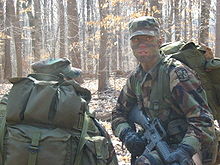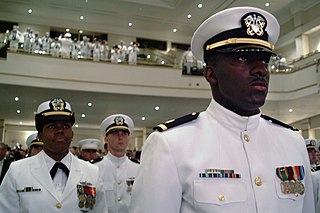
The Reserve Officers' Training Corps is a group of college- and university-based officer-training programs for training commissioned officers of the United States Armed Forces.
An officer candidate school (OCS) is a military school which trains civilians and enlisted personnel in order for them to gain a commission as officers in the armed forces of a country. How OCS is run differs between countries and services. Typically, officer candidates have already attained post-secondary education, and sometimes a bachelor's degree, and undergo a short duration of training which focuses primarily on military skills and leadership. This is in contrast with a military academy which includes academic instruction leading to a bachelor's degree.

The Texas A&M University Corps of Cadets is a student military organization at Texas A&M University. Established with the university in 1876, it is the oldest student organization on campus.
Officer Cadet is a rank held by military cadets during their training to become commissioned officers. In the United Kingdom, the rank is also used by members of University Royal Naval Units, University Officer Training Corps and University Air Squadron; however, these are not trainee officers with many not choosing a career in the armed forces.

The Virginia Tech Corps of Cadets (VTCC) is the military component of the student body at Virginia Polytechnic Institute and State University. Cadets live together in residence halls, attend morning formation, wear a distinctive uniform, and receive an intensive military and leadership educational experience similar to that available at the United States service academies. The Corps of Cadets has existed from the founding of the Virginia Agricultural and Mechanical College in 1872 to the present-day institution of Virginia Tech, which is designated a senior military college by federal law. As of August 2021, about 1,200 cadets are currently enrolled in the program.

The Air Force Reserve Officers' Training Corps (AFROTC) is one of the three primary commissioning sources for officers in the United States Air Force and United States Space Force, the other two being the United States Air Force Academy (USAFA) and Air Force Officer Training School (OTS). A subordinate command of the Air University within the Air Education and Training Command (AETC), AFROTC is aligned under the Jeanne M. Holm Center for Officer Accessions and Citizen Development at Maxwell AFB, Alabama. The Holm Center, formerly known as the Air Force Officer Accession and Training Schools (AFOATS), retains direct responsibility for both AFROTC and OTS.

Norwich University – The Military College of Vermont is a private senior military college in Northfield, Vermont. It is the oldest private and senior military college in the United States and offers bachelor's and master's degrees on-campus and online. The university was founded in 1819 in Norwich, Vermont, as the American Literary, Scientific and Military Academy. It is the oldest of six senior military colleges and is recognized by the United States Department of Defense as the "Birthplace of ROTC".

The United States Army Airborne School—widely known as Jump School—conducts the basic paratrooper training for the United States Armed Forces. It is operated by the 1st Battalion (Airborne), 507th Infantry, United States Army Infantry School, Fort Moore, Georgia. The Airborne School conducts the Basic Airborne Course, which is open to troops from all branches of the United States Department of Defense, Reserve Officer Training Corps, and allied military personnel.

Marion Military Institute, the Military College of Alabama, is a public military junior college in Marion, Alabama. Founded in 1842, it is the official state military college of Alabama and the nation's oldest military junior college.

The University of Oklahoma Army ROTC is the primary officer training and commissioning program at the University of Oklahoma and one of the oldest in the nation, having existed in some form since the First World War. It is known as the "Sooner Battalion" and is notable for having produced thousands of officers for the United States Army, including 19 general officers. It is led by three officers and two noncommissioned officers.
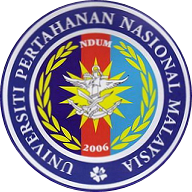
The National Defence University of Malaysia is a military university located in Sungai Besi Camp, Kuala Lumpur, Malaysia.

An officer is a person who holds a position of authority as a member of an armed force or uniformed service.
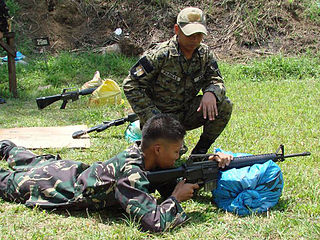
Reserve Officers' Training Corps (ROTC) in the Philippines is one of three components of the National Service Training Program, the civic education and defense preparedness program for Filipino college students. ROTC aims to provide military education and training for students to mobilize them for national defense preparedness. Its specific objectives include preparation of college students for service in the Armed Forces of the Philippines in the event of an emergency and their training to become reservists and potential commissioned officers of the AFP.

The Army Reserve Officer Training Corps (AROTC) is the United States Army component of the Reserve Officers' Training Corps. It is the largest Reserve Officer Training Corps (ROTC) program which is a group of college and university-based officer training programs for training commissioned officers for the United States Army and its reserves components: the Army Reserves and the Army National Guard. There are over 30,000 Army ROTC cadets enrolled in 274 ROTC programs at major universities throughout the United States. These schools are categorized as Military Colleges (MC), Military Junior Colleges (MJC) and Civilian Colleges (CC).
Reserve Officers' Training Corps in South Korea is a college-based officer training program which was established in 1961. South Korea's Conscription Law applies to males, aged between 18 and 35, although women are allowed to enroll in the ROTC as of 2010.

The Junior Reserve Officer Training Corps is a federal program sponsored by the United States Armed Forces in high schools and also in some middle schools across the United States and at US military bases across the world. The program was originally created as part of the National Defense Act of 1916 and later expanded under the 1964 ROTC Vitalization Act.

The University of Santo Tomas Golden Corps of Cadets (UST-GCC) also referred to as the UST ROTC Unit is a Reserve Officers' Training Corps unit implementing one of the optional components of the Philippines' National Service Training Program (NSTP) in the University of Santo Tomas. The NSTP is a civic education and preparedness program for college students, the ROTC component of which aims to provide military education and training to mobilize them for national defense preparedness.
The Air Force Reserve Officer Training Corps (ROTC) at Pennsylvania State University, known as Detachment 720, provides undergraduate students the opportunity to earn a commission as a second lieutenant in the United States Air Force immediately upon graduation from Penn State. The Air Force ROTC program takes 3 to 4 years to complete. Students do not incur an obligation to the Air Force unless they have accepted a scholarship or have entered the Professional Officer Course.

Oregon State University Army ROTC is an ROTC Battalion assigned to Oregon State University in Corvallis, Oregon. Its mission is to train Cadets in basic military leadership and commission them as 2nd Lieutenants upon the completion of a bachelor's degree. Founded in 1873, the ROTC Battalion has continued to serve the nation and US Army Cadet Command and was given the nickname, "The West Point of the West" after it produced more commissioned officers than any other ROTC Battalion in the USA during World War II.
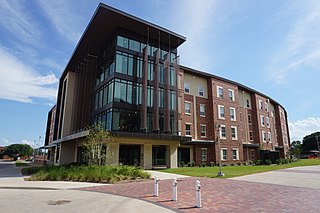
The Texan Corps of Cadets is a student military organization at Tarleton State University located on the university's main campus in Stephenville, Texas. Tarleton's original Corps of Cadets traces its roots to 1917 but was reactivated in 2016 after becoming inactive in the 1950s. Tarleton is a member of the Association of Military Colleges & Schools of the United States.



